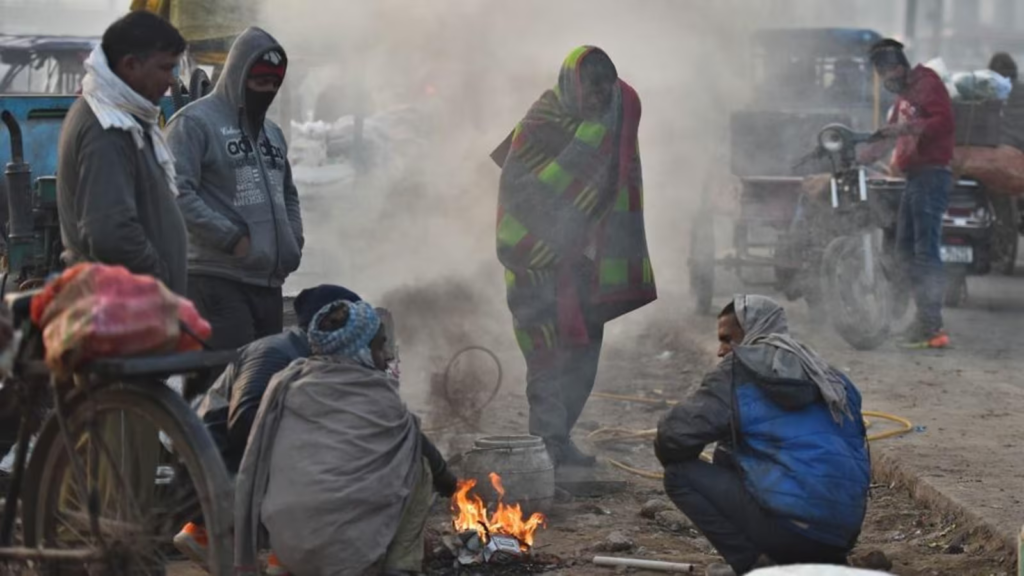During the day, Delhi experienced a minimum temperature of 5.8°C and a maximum of 18.1°C, with sunlight contributing to the rise in daytime temperatures.
Delhi has not experienced a “cold wave” this winter, which is characterized by the minimum temperature falling 4.5 degrees Celsius (°C) or more below normal, as per the India Meteorological Department (IMD). This absence of a cold wave is attributed to the persistent dense layer of upper-level fog over the northern plains for the past two weeks.

Delhi registered a low of 5.8°C and a high of 18.1°C, with daytime temperatures getting a boost from sunlight. However, the clearing skies also resulted in colder nights.
In January, the minimum temperature in Delhi has not fallen below 5°C. The lowest temperature this winter, reaching 4.9°C, occurred on December 15. Even though the city has not experienced extremely low temperatures, there have been three “cold days” this season, characterized by maximum temperatures being 4.5°C or more below normal, resulting in chilly daytime conditions. Weather officials attribute this to persistent dense fog, limiting sunlight and keeping the maximum temperature below 20°C until Thursday.

During the night, the thick fog hinders the escape of the heat that has accumulated on the surface during the day, thus preventing nighttime temperatures from dropping too much, explained Kuldeep Srivastava, a scientist at IMD. He added that as the fog cleared across the northern plains on Thursday, there is a likelihood of nighttime lows decreasing on Friday.
In the corresponding period of previous years until January 11, the minimum temperature has dropped as low as 1.1°C. Interestingly, several seasonal lows were recorded on January 1 in previous years, with the minimum temperature reaching 1.9°C in 2023 (January 8), 4.2°C in 2022 (January 1), 1.1°C in 2021 (January 1), 2.4°C in 2020 (January 1), and 4°C in 2019 (January 1). However, on January 1 this year, the minimum temperature in Delhi was 10.1°C.
The India Meteorological Department (IMD) predicts that the minimum temperature could reach 5°C on Friday. However, a western disturbance is anticipated to introduce cloudiness in the region, causing the minimum temperature to rise again to 8-9°C.
In the preceding days, Delhi experienced a minimum of 7.1°C on Wednesday and 7.8°C on Tuesday.
“The minimum temperature at Safdarjung, Delhi’s main weather station, is expected to be in the range of 4.5°C to 5.5°C. With limited fog and cloud cover to trap heat, we anticipate a slight dip. Subsequently, two consecutive western disturbances are expected to reintroduce cloudiness, resulting in nighttime temperatures around 8-9°C until January 17,” stated Srivastava.
Thursday experienced generally sunny and windy conditions, causing the maximum temperature to reach 18.1°C, which is two degrees below the normal range. This was a notable increase from the previous day’s maximum temperature of 15.2°C.
IMD officials noted that January’s weather has been reminiscent of 2022, characterized by dense fog leading to elevated minimum temperatures. However, even in 2022, the minimum temperature dropped lower than it has during this January, as mentioned by Srivastava.
In December, the average monthly minimum temperature concluded at 8.5°C, which was slightly above the monthly long-term average by 0.1°C. This marked the highest average minimum for December in six years, surpassing the 2017 figure of 9.1°C.
For the first 11 days of January, the average minimum temperature has been 7.8°C, nearly a degree higher than the long-term average of 6.9°C.
Friday’s forecast indicates abundant sunshine during the day, with the maximum temperature expected to be around 19°C and the minimum around 5°C. On Saturday, the maximum is projected to remain around 19°C, and the minimum might increase to 8°C.
On Thursday, Delhi experienced shallow fog, while dense fog was recorded for an hour (between 4 am and 5 am) with visibility dropping to 100 meters at Palam. This brief period of dense fog resulted in a few flight delays at the Indira Gandhi International (IGI) airport. Northern Railway reported around 24 trains facing delays of approximately an hour during the early hours.
Mahesh Palawat, the vice president at the private forecaster Skymet, highlighted that the warm nights over the past two weeks can be attributed to the absence of sunlight and clear skies. Typically, the first two weeks of January witness the lowest minimum temperatures of the season. The prevalence of dense fog across the northern plains has constrained the minimum temperature and contributed to a decline in the maximum temperature. Palawat noted that the second half of January tends to be relatively warmer, and he anticipates a further rise in the minimum temperature after January 15. Similar conditions have been observed in other parts of northwest India this season.
At 4 pm on Thursday, Delhi’s 24-hour average air quality index (AQI) worsened to 348 (considered very poor), according to the Central Pollution Control Board’s bulletin. This marked a deterioration from the previous day when the AQI was 273 (categorized as poor). After 20 days, Delhi’s air had improved to the “poor” category.
Forecasts from the Early Warning System (EWS) for Delhi, a forecasting model under the Ministry of Earth Sciences, indicate that the AQI is likely to remain “very poor” from January 12 to 14. The outlook for the subsequent six days also suggests that the air quality will persist in the “very poor” category, as stated by EWS in its daily bulletin.

